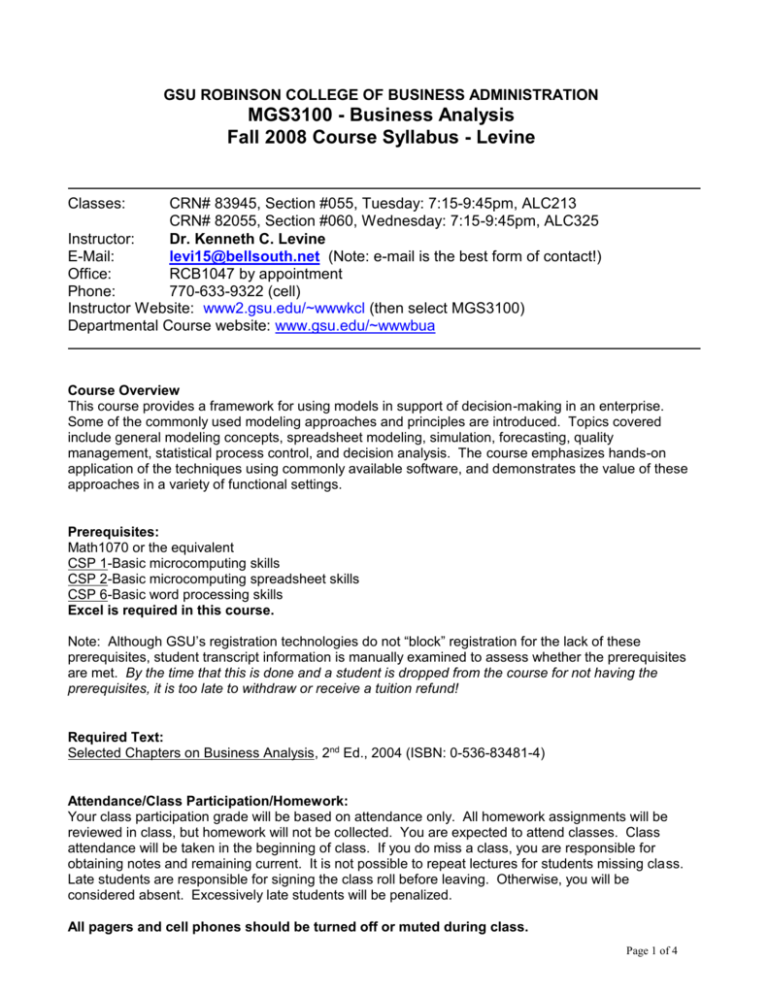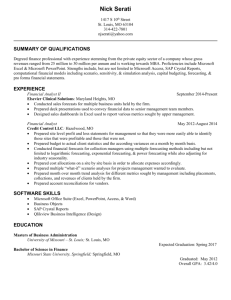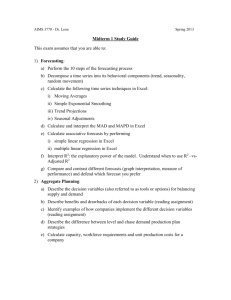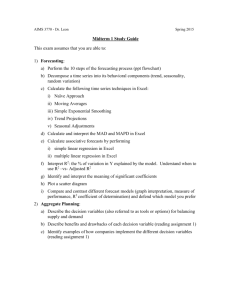General Modeling Fundamentals/Simulation
advertisement

GSU ROBINSON COLLEGE OF BUSINESS ADMINISTRATION MGS3100 - Business Analysis Fall 2008 Course Syllabus - Levine Classes: CRN# 83945, Section #055, Tuesday: 7:15-9:45pm, ALC213 CRN# 82055, Section #060, Wednesday: 7:15-9:45pm, ALC325 Instructor: Dr. Kenneth C. Levine E-Mail: levi15@bellsouth.net (Note: e-mail is the best form of contact!) Office: RCB1047 by appointment Phone: 770-633-9322 (cell) Instructor Website: www2.gsu.edu/~wwwkcl (then select MGS3100) Departmental Course website: www.gsu.edu/~wwwbua Course Overview This course provides a framework for using models in support of decision-making in an enterprise. Some of the commonly used modeling approaches and principles are introduced. Topics covered include general modeling concepts, spreadsheet modeling, simulation, forecasting, quality management, statistical process control, and decision analysis. The course emphasizes hands-on application of the techniques using commonly available software, and demonstrates the value of these approaches in a variety of functional settings. Prerequisites: Math1070 or the equivalent CSP 1-Basic microcomputing skills CSP 2-Basic microcomputing spreadsheet skills CSP 6-Basic word processing skills Excel is required in this course. Note: Although GSU’s registration technologies do not “block” registration for the lack of these prerequisites, student transcript information is manually examined to assess whether the prerequisites are met. By the time that this is done and a student is dropped from the course for not having the prerequisites, it is too late to withdraw or receive a tuition refund! Required Text: Selected Chapters on Business Analysis, 2nd Ed., 2004 (ISBN: 0-536-83481-4) Attendance/Class Participation/Homework: Your class participation grade will be based on attendance only. All homework assignments will be reviewed in class, but homework will not be collected. You are expected to attend classes. Class attendance will be taken in the beginning of class. If you do miss a class, you are responsible for obtaining notes and remaining current. It is not possible to repeat lectures for students missing class. Late students are responsible for signing the class roll before leaving. Otherwise, you will be considered absent. Excessively late students will be penalized. All pagers and cell phones should be turned off or muted during class. Page 1 of 4 General Course Objectives: To demonstrate the application of models in support of decision making in an enterprise, using some of the most commonly used modeling approaches and principles. Upon completion of the course, the student should: A. Demonstrate competence in analysis/development of some common models mathematically B. Demonstrate competence in analysis/development of some common models graphically C. Demonstrate competence in using a spreadsheet for analysis D. Interpret model results in the context of the business situation and explain in plain language Specific Course Objectives: In order to earn a grade of ‘A’ in the course, the student should, upon completion, be able to: General Modeling: 1. Define basic modeling terms, including (but not limited to) Physical model, Analog model, Symbolic model, Deterministic model, Probabilistic model, Decision Variable, Random Variable, Parameter, Performance measure, Objective function, Revenue, Fixed Cost, Variable Cost, Overhead Cost, Sunk Cost, Demand, Price 2. Explain the modeling process, including model types, data collection, analysis, interpretation 3. Analyze a business situation to identify revenues, costs, and other relevant parameters 4. Draw an influence diagram to map the relationships between different variables of interest 5. Build a basic profit model both with a spreadsheet and without 6. Perform Breakeven analysis algebraically and graphically, both with a spreadsheet and without 7. Perform Crossover analysis algebraically and graphically, both with a spreadsheet and without 8. Interpret the results of Breakeven and Crossover analyses Forecasting: 9. Define the types of forecasting - Quantitative (causal and time series) and Qualitative. 10. Forecast using the following methods for time-series data (on a spreadsheet): a) Naïve b) Moving Averages c) Simple Exponential Smoothing d) Trend (linear only) e) Seasonal Analysis (simplified approach) f) Regression 11. Compute Bias, MAD (Mean Absolute Deviation), MAPE (Mean Absolute Percentage Error), Standard Error, and R-Squared 12. Compare and contrast the different forecasting methods 13. Interpret the results of the different forecasting methods Decision Analysis 14. Differentiate between decision making under ignorance, risk, and certainty 15. Define the terms Decision Alternative, States of Nature, Payoff 16. Compute payoff matrix for a given business scenario 17. Define the criteria for choosing the best decision 18. Determine the best decision using the MAXIMAX, MAXIMIN 19. Compute Expected Value (EV or ER), EV under/with Perfect Information (EVUPI or EVwPI), and EV of Perfect Information (EVPI) 20. Construct and solve a decision tree by assigning payoffs to branches, pruning of branches at decision nodes, and assigning probabilities and calculating expected values at chance nodes 21. Combine sample data with prior probabilities using Bayes’ Theorem, and incorporate these “posterior” probabilities into a decision tree analysis Page 2 of 4 Simulation 22. Compare and contrast simulation with other types of modeling 23. Determine when simulation is an appropriate technique to use 24. Use random numbers from a random number table or a spreadsheet function 25. Apply simulation techniques to machine break-down, queuing, and inventory problems 26. Graph and interpret the results of the simulations Quality Management 27. Understand the basic concepts of Quality Management, including Six Sigma 28. Understand the difference between common cause and special cause variation 29. Understand how control charts can be used to help manage by exception 30. Create control charts for attribute and variable measures 31. Calculate process capability; understand how to determine the “sigma” level of a process Grading: Competency Exercise Tests Projects Homework Attendance Final Exam Excel Spreadsheet Analysis 3 Tests 2 Projects Various Lose one point per absence Common Departmental Exam 0 pts. (but required!) 60 pts. (20 pts. each) 20 pts. (10 pts. each) 0 pts. (not collected) 10 pts. (one free absence) 10 pts. The grading scale for this class is as follows: A: 94-100; A-: 90-93.9; B+: 86-89.9; B: 82-85.9; B-: 78-81.9; C+: 74-77.9; C: 70-73.9; C-: 66- 69.9; D: 60.0 - 65.9; F: < 60.0 Professional and personal circumstances that preclude you from performing at satisfactory levels will not be considered in the determination of the course grade. The effect of your grade on overall GPA, eligibility for graduation, loss of scholarship, loss of a United States resident card, placement on academic probation, etc., are not considered in the determination of your grade. There are no extra credit assignments. Individual requests for alternative ways to improve your course grade will not be considered. Honor Code: Plagiarism in any form is not acceptable. While discussion with classmates regarding homework and projects is encouraged, all work submitted must be your own. Evidence of plagiarism on an assignment/exam will result in a failing grade for that assignment/exam. Examinations: Tests will be administered in class according to the attached schedule. Tests may be a mixture of multiple choice and true/false. Class tests and the common final will test both your understanding of concepts and problem solving ability, and will also include questions about the use of Excel to solve problems in this course. For in-class tests and the common final exam, you will need to bring a calculator (with a square root button!) and one 8.5”x11” page of notes (two-sided). Students are required to provide their own pencils and scratch paper. All material needed for tests and the final exam will be covered in class. A sample final exam and answer key can be found on the departmental web site. All students are required to take the final exam. Individual Student Projects: Individual class projects will be discussed in class. These are not group projects! Projects are to be submitted on paper by each student by the designated date, including data output and formulas. No diskettes will be accepted, as they are easily misplaced and damaged. Late projects will be penalized at a rate of 5% per calendar day. In addition, once the deadline has passed, no further feedback will be given. Use the “fit to one page” option to print your output on 8.5x11” sheets. No report covers, please! You may discuss projects with your classmates, but the work you turn in must be your own! Page 3 of 4 Schedule: The following is a tentative schedule; deviations may be necessary. Supplementary homework assignments will be added as the course progresses. Date Topic Detailed Outline (Tues/Wed): General Modeling Fundamentals/Simulation 1. 8/19; 8/20 Overview of Course introduction and overview; Modeling for The nature of modeling for decision-making; Decision Implementation issues. Making Discuss Excel Competency Exercise 2. 8/26; 8/27 Business Effective use of spreadsheets for modeling; Modeling Sensitivity/what-if analysis; Spreadsheet Review of key Excel functions; Techniques Financial Models; Influence diagrams Chapter Assignments Course Syllabus 1 11 HW1 (Discussion questions): 1-1, 1-2, 1-4, 1-6, 1-12, 1-18 (not collected) HW2: Excel Competency Exercise (on website) 3. 9/2; 9/3 2 (skim only); BE/CO lecture; 9 (excl. pp.164-67, 174-82, 192, 210) 9 (excl. p.164-67, 174-82, 192-210) 4. 9/9; 9/10 Spreadsheet Techniques; Monte Carlo Simulation Monte Carlo Simulation 5. 9/16; 9/17 Breakeven and crossover analysis; Introduction to Simulation; Random numbers; Probability distributions; Machine breakdown problem; Queuing applications Building a spreadsheet simulation: Inventory applications; Discuss Project #1 (Simulation); Review for Quiz#1 (See Sample Final and Key on departmental website.) Quiz #1 Forecasting/Quality Management 5. 9/16; 9/17 Forecasting Intro to Forecasting; Qualitative Models 6. 9/23; 9/24 Forecasting 7. 9/30; 10/1 Forecasting 8. 10/7; 10/8 Forecasting 9. 10/14; TQM/SPC 10/15 10. 10/21; TQM/SPC 10/22 11. 10/28; 10/29 Decision Analysis 11. 10/28; Decision 10/29 Analysis 12. 11/4; 11/5 Decision Analysis 13. 11/11; 11/12 Decision Analysis 14. 11/18; 11/19 Decision Analysis 15. 12/2; 12/3 Decision Analysis Final Exam Tues., 12/9; Wed., 12/10 2 (skim only) HW3: Simulation (Handout) HW4: Simulation (Handout) 13 (excluding pp. 280-4, 300-2, 307-9) Go over Quiz #1; Time-series forecasting models: Naïve forecasts; Moving averages; Error measures: Bias, MAD, MAPE. Time-series forecasting models: Simple exponential smoothing; Trend analysis. Time series decomposition/seasonality; Causal modeling/Regression; Discuss Project #2 (Forecasting). TQM Overview; Six Sigma philosophy; Process improvement tools. SPC Overview: Process measurement; Control charts; Process capability. Quiz #2 13 (excluding pp. 280-4, 300-2, 307-9) Basic concepts; Ignorance, risk, and certainty; Payoff tables; Alternatives; States of nature; Payoffs; Decision making under ignorance: Maximax, Maximin Go over Quiz #2; Decision making under risk; Expected value; Expected value of perfect information; Creating payoff matrices. Sequential decisions and decision trees; Conditional probability and Bayes’ Theorem; Expected value of sample information; Efficiency Sequential decisions and decision trees; Conditional probability and Bayes’ Theorem (continued) Quiz #3; Review for Final Comprehensive Departmental Final Exam: 8 (excluding pp.92, 94-101, 109-111) 13 (excluding pp. 280-4, 300-2, 307-9) 13 (excluding pp. 280-4, 300-2, 307-9) Project#1 due 15 (excluding pp.339-41, 357) 15 (excluding pp.339-41, 357) 8 (excluding pp.92, 94-101, 109-111) Project#2 due 8 (excluding pp.92, 94-101, 109-111) 8 (excluding pp.92, 94-101, 109-111) 7:15-9:15pm Page 4 of 4








